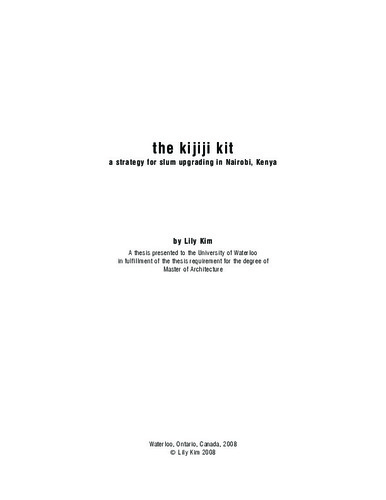UWSpace will be migrating to a new version of its software from July 29th to August 1st. UWSpace will be offline for all UW community members during this time.
The Kijiji Kit: A Slum Upgrading Strategy for Nairobi, Kenya
| dc.contributor.author | Kim, Lily | |
| dc.date.accessioned | 2008-01-25 19:20:55 (GMT) | |
| dc.date.available | 2008-01-25 19:20:55 (GMT) | |
| dc.date.issued | 2008-01-25T19:20:55Z | |
| dc.date.submitted | 2008-01-23 | |
| dc.identifier.uri | http://hdl.handle.net/10012/3549 | |
| dc.description.abstract | This thesis is sited in Mukuru-Kwa-Njenga, a slum community in Nairobi, Kenya. Like many others around the world, this community faces issues of health, sanitation, mobility, and basic services. Through the investigation of these issues, a set of guidelines have been developed to help this slum community become a responsible and supportive environment that promotes participation from its residents, local governments, and the global population. After first acknowledging the complexity of the situation with regards to the formation and growth of slums, and the multi-layered problems that exist within them, the guidelines presented here are combined and herein named “Kijiji Kit”. “Kijiji” means “communal settlement” in Swahili. Hence, the Kijiji Kit is a resource tool for slum communities that can help build communal living environments for the urban poor. It consists of probable methods of zoning processes (determined through site analysis), community infrastructure essentials (such as health care and educational facilities), and individual infrastructure systems (such as rainwater collection). It is not a physical entity but a long-term working model of the community operating on three scales: city, community, and individual. On a city scale, collaboration between governments, institutions, municipalities, public and private sectors, and the community is integral. The responsibilities of the state, specifically in terms of funding and policies, play a significant factor in strengthening urban slums. On a community scale, certain infrastructural systems and basic services are required, such as public transit, health care, and housing to ensure that proper support exists for the community to function effectively. Slum upgrading is one method that can begin helping communities develop resourcefully and independently. Finally, the individuals who form the community must be active participants in the processes that affect them. They must want change and be willing to put the time and dedication into the processes that will bring positive growth to their community. Based on the basic needs of the most vulnerable population – the orphans – the Kijiji Kit is a comprehensive and holistic approach to improving life in urban slums and calls for an overlapping of many disciplines, including architecture. Architecture is an essential component in developing and structuring communities. This thesis explores the social impact of architecture and how it can bring change to both the physical and social environment of slum communities. | en |
| dc.language.iso | en | en |
| dc.publisher | University of Waterloo | en |
| dc.subject | slum | en |
| dc.subject | Africa | en |
| dc.title | The Kijiji Kit: A Slum Upgrading Strategy for Nairobi, Kenya | en |
| dc.type | Master Thesis | en |
| dc.pending | false | en |
| dc.subject.program | Architecture | en |
| uws-etd.degree.department | School of Architecture | en |
| uws-etd.degree | Master of Architecture | en |
| uws.typeOfResource | Text | en |
| uws.peerReviewStatus | Unreviewed | en |
| uws.scholarLevel | Graduate | en |

